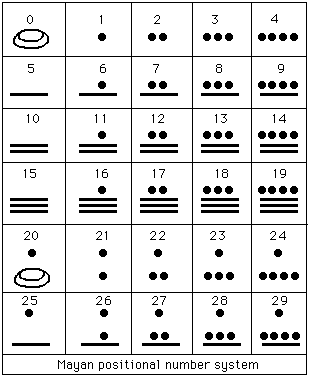- No assignment due this week. I'll post a new assignment on Friday, concerning bases.
- New reading assignment: make sure that you read about the Mayans, and their base 20 system.
- Question of the day(s): What other civilizations used curious bases?
- How can we understand representations in different bases?
- A base is a natural number, a counting number, larger than 1.
- Each number is written using only powers of that
base, starting from the power 0 (since anything to the power 0
is 1): for example,
-
- There are as many digits as the base: so base two uses only two digits (0 and 1); base 10 uses only 10 digits (0 through 9).
- The number is written so that each digit falls in a place, which represents a unique power of the base.
- The Great Fraudini writes numbers in base 2 (see p. 11 of our
text) -- that is, using powers of two.
197 57 How would we write these numbers in base 2?
197 57 - Last time we saw how the hexadecimal (base 16) system is used in
web pages, to create colors using values for red, green, and blue (RGB,
written as a string of "digits" in hex). The color for this page is
#FFF8DC.
- Translating between bases
- Write 253 (written here in base 10) in base 2
- Write 1001011012 (written here in base 2) in base 10
- Write 253 (written here in base 10) in base 8
- Write 1001011018 (written here in base 8) in base 10
- Write 253 (written here in base 10) in base 16
- Write 10010110116 (written here in base 16) in base 10
- The Mayans used a curious number system:

Your reading assignment is to inform you a little more about this curious system. You will learn a little about the famous Mayan calendar.
- Now: let's play detective
in the times of Babylon.....
- "...a cuneiform tablet measuring perhaps 3 inches by 5. The markings can
be made by pressing the end of a cut reed into wet clay. Dating such a tablet
is seldom easy. The appearance of this tablet suggests that it may have been
made in Akkad in the city of Nippur in the year -1700, about 3700 years ago."
- Answer the author's three questions:
- What is this and what are its properties?
- What was its original purpose?
- What does this tell me about the culture that produced it?
- "...a cuneiform tablet measuring perhaps 3 inches by 5. The markings can
be made by pressing the end of a cut reed into wet clay. Dating such a tablet
is seldom easy. The appearance of this tablet suggests that it may have been
made in Akkad in the city of Nippur in the year -1700, about 3700 years ago."